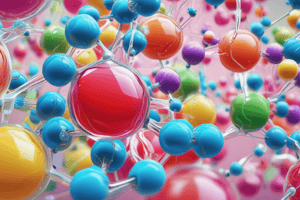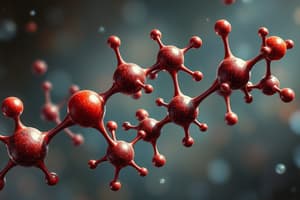Podcast
Questions and Answers
Lipids function primarily as ______ energy.
Lipids function primarily as ______ energy.
stored
Carbohydrates are made of carbon and ______.
Carbohydrates are made of carbon and ______.
water
Proteins are primarily responsible for ______.
Proteins are primarily responsible for ______.
structure
Nucleic acids contain ______ information.
Nucleic acids contain ______ information.
The process of making a larger molecule by removing water is called ______ synthesis.
The process of making a larger molecule by removing water is called ______ synthesis.
Proteins are used to build ______.
Proteins are used to build ______.
The building blocks of proteins are ______ acids.
The building blocks of proteins are ______ acids.
DNA stands for Deoxyribo ______ Acid.
DNA stands for Deoxyribo ______ Acid.
The basic unit of nucleic acids is called a ______.
The basic unit of nucleic acids is called a ______.
Fried food and butter are examples of foods high in ______.
Fried food and butter are examples of foods high in ______.
In the body, enzymes are proteins that control ______.
In the body, enzymes are proteins that control ______.
RNA stands for Ribo ______ Acid.
RNA stands for Ribo ______ Acid.
To maintain a healthy weight, the number of calories consumed must equal the number of calories ______.
To maintain a healthy weight, the number of calories consumed must equal the number of calories ______.
Flashcards are hidden until you start studying
Study Notes
Organic Chemistry
- The word "organic" in chemistry refers to compounds containing carbon, commonly found in living organisms
- It is often used in non-scientific contexts to describe food products that are natural, free from preservatives, hormones, and pesticides.
Bio-molecules
- Proteins are responsible for building structures in living organisms.
- Lipids serve as stored energy and contribute to insulation.
- Carbohydrates provide readily available energy.
- Nucleic acids store and transmit genetic information.
Carbon Molecules
- Carbon is located in group four of the periodic table.
- Carbon needs four electrons to fill its outer shell, forming four covalent bonds.
- Carbon's significance in biological molecules makes their study a distinct field known as organic chemistry.
Chemical Processes
- Dehydration synthesis is the process of joining smaller molecules together by removing water.
- Hydrolysis is the process of breaking larger molecules into smaller ones by adding water.
- ATP is an energy-carrying molecule.
Carbohydrates
- Carbohydrates are composed of carbon and water.
- They serve as readily available energy source.
- Simple carbohydrates, also known as sugars, include monosaccharides and disaccharides.
- Glucose (C6H12O6) is an example of a monosaccharide.
- Complex carbohydrates, also known as starches, are polysaccharides and include foods like breads, pasta, and potatoes.
Lipids
- Lipids, commonly known as fats, store energy and function in insulation.
- They consist of a glycerol molecule bonded to three fatty acids.
- Triglycerides, phospholipids, waxes, and steroids are examples of lipids.
Types of Lipids
- Saturated fats are filled with hydrogen, with only single bonds between carbon atoms. They are typically solid at room temperature and can potentially contribute to hardened arteries due to their larger size.
- Unsaturated fats do not have a maximum amount of hydrogen bonds. They are typically liquid at room temperature and often better for health compared to saturated fats. Examples include vegetable oils.
- Cis, trans, and omega-3 are different types of unsaturated fats.
Proteins
- Proteins are essential for building structures within living organisms.
- They are long chains of amino acids, typically containing 500 to 2000 amino acids.
- There are twenty unique amino acids, similar to letters forming words.
- Enzymes are proteins that control processes in the body.
Nucleic Acids
- Nucleic acids act as blueprints for life, providing instructions for protein synthesis.
- DNA (Deoxyribonucleic Acid) and RNA (Ribonucleic Acid) are the two types of nucleic acids.
Nucleic Acid Structure
- Nucleic acids are composed of nucleotides.
- Each nucleotide comprises a sugar, a phosphate group, and a nitrogen base, which could be A, T (or U), G, or C.
DNA vs. RNA
- DNA and RNA differ in their sugar, nitrogen base composition, length, and structure.
- DNA has deoxyribose sugar, ATGC bases, is longer, and exists as a double helix, remaining in the nucleus.
- RNA has ribose sugar, AUGC bases, is shorter, exists as a single strand, and different types can travel within the cell.
Nutrition
- Vitamins and minerals are essential components of a healthy diet.
Diets and Weight Management
- Maintaining a healthy weight involves balancing calorie intake and calorie expenditure.
- A food item that does not provide satiety can lead to increased food consumption and calorie intake.
Studying That Suits You
Use AI to generate personalized quizzes and flashcards to suit your learning preferences.




